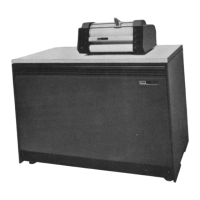Specifying
Alphameric
Fields
40
program automatically adjusts
the
value of the exponent to indicate
the
actual
position of
the
decimal.
The
number
of significant digits
that
will
be
printed
can
be
determined
by
the
following rules:
if w
~
14,
then
8 significant digits are
printed
if w < 14,
then
w-6
significant digits are
printed
The
following examples show how each of the quantities on
the
left
is
printed according to the specification E10.3:
Value
In
Storage
Printed
-.008
8000000602
-8.000E-03
.472
4720000000
b4.720E-01
.00000000006 6000000010
b6.000E-11
-10.0468
1004680002
-1.004E+01
1234567.8
1234567807
b1.234E+06
If
your specification
is
not
large enough, the program will automatically use the
specification E14.8.
In
the
examples just given,
it
can
be
seen
that
you must know the
data
in
order to specify a satisfactory format. Your specifications should provide for the
largest
number
of significant mantissa digits transmitted with the greatest ac-
curacy required.
Alphameric
data
can
be
read
into the
FORTRAN
program from cards,
paper
tape,
or the typewriter. This
data
can
be
contained in
the
program and
printed
or
punched as
part
of the
output
data. Alphameric fields
are
often used to identify
totals or certain phases of
the
program.
The
following are typical
output
mes-
sages:
PROGRAM
ERROR
OHMS,
......
VOLTS
END
OF
PROGRAM
R C JONES
Alphameric fields require the
FORMAT
specification of
wH,
where w is
the
num-
ber
of alphameric characters, including blanks,
in
the
message.
The
first message shown above could
be
typed
by
the
following statements:
TYPE 9
9
FORMAT
(14H
PROGRAM
ERROR)
(The
count of 14 includes a blank position before
and
after "program.")
The
next message
in
the
example illustrates how totals can
be
identified in
the
program. A
print
statement
would
be
PRINT
6,0,
V
and the
FORMAT
statement
might
be,
6
FORMAT
(lHO, F6.2,
5H
OHMS, F6.2,
6H
VOLTS)
The
two
preceding
examples show ,how alphameric
data
is entered
by
a state-
ment
in
the
source program. Alphameric
data
can also
be
read
from individual

